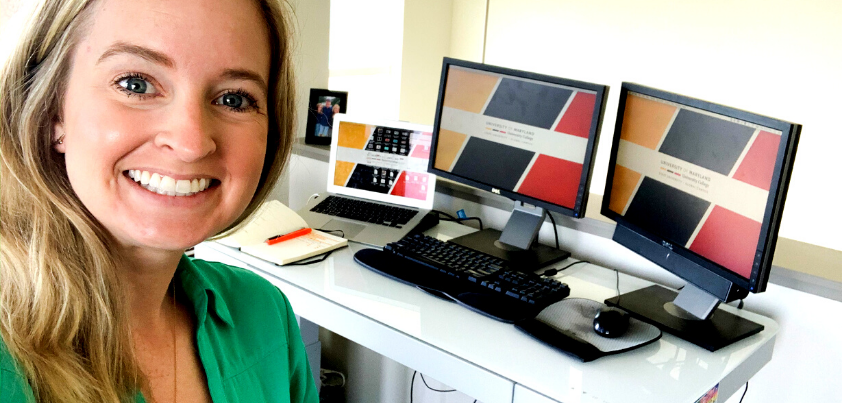Top tips from UMGC’s “Veteran” Teleworking Employees

As UMGC adjusts to teleworking for nonessential employees following Maryland Governor Larry Hogan's recent coronavirus directive, UMGC "veteran" teleworking employees share some tried and tested tips for work-from-home success. With over 26 years of combined teleworking experience between them, eight UMGC employees took some time from their work-from-home schedules to share their insights, tips, and strategies with those who are new to the world of telework.
Meet our panel of experienced teleworkers
Marsha Fortney, Academic Affairs; Bethany Allen, Strategic Enrollment Management; Julie Harvey, Human Resources; Pete Haugland, Stateside Military Operations; Susana Macias, Strategic Enrollment Management; David Miller, Institutional Advancement; Matthew Selzer, Global Military Operations and Rachel Shannon, Institutional Advancement, provided some essential pointers for newcomers to telework.
While our interviewees work across multiple UMGC divisions and have varying roles, their tips and insights reflected some consistent themes:
Setting up your workspace
"I have a workspace separate from the living areas of my house," said Bethany Allen, Strategic Enrollment Management. "It helps me to be in the right headspace for work and to wind down at the end of the day. It also allows me to draw some boundaries with my family." Allen added, "They know that when the office door is shut, I'm at work."
Bethany Allen, Strategic Enrollment Management
Julie Harvey, Human Resources, said employees should try to make their "workstation as ergonomic as possible. Don't work at the kitchen table, couch or other location where you might not be able to practice good posture. It will make a difference at the end of the day."
"Make a few adjustments if you're going to be using Zoom regularly," offered Marsha Fortney, Academic Affairs. "Invest in a headset. And lighting is also key. I have a lamp behind my laptop and it's shining toward the wall. The diffused light is more camera-friendly. Don't be afraid of the camera! If you normally see your colleagues in person each day, seeing them on camera each day is much the same!"
Preparation and organization
"I always make sure to get to my office space at least five to10 minutes before [the] scheduled time. This way, if I need to do any type of troubleshooting, I have time before my workday starts," said Susana Macias, Strategic Enrollment Management.
Susana Macias, Strategic Enrollment Management
In addition to contact details for the IT help desk, Macias also makes sure to have supplies such as "pens, note pads and stickies," her department contact information and recent e-mails with important announcements, as well as other helpful resources near her workspace.
And employees should be prepared for that last-minute video conference, Harvey advised. "Prepare yourself for work just as if you were going out of the house. Dress [in] business casual. You never know when you might want or need to video conference with teammates. You also feel more confident and professional if you dress the part."
Pete Haugland, Stateside Military Operations
Noise-canceling headphones are a must for Peter Haugland, Stateside Military Operations, whose job requires attention to detail. "I feel I can stay better focused at home, although this is a bit more difficult now with the whole family home, so I find noise-canceling headphones helpful."
Optimize your schedule for wellness and productivity
Fortney offered some thoughtful advice on how to create a schedule that aligns workload with well-being. "In addition to managing your time, it's imperative to manage your energy," she said. "I am more focused and energetic very early in the morning, so I am usually at my computer by 5:30 a.m. The amount of work I can complete during the first two hours of my workday is comparable to what I could accomplish in twice the amount of time in the afternoon.
Marsha Fortney, Academic Affairs
"Think about what fills your tank. Maybe it's taking the dogs out for a 20-minute walk, tuning into your favorite yoga video, or setting up a virtual coffee break with friends or colleagues," she added. "Use those times as springboards to productivity!"
Haugland also likes to take his dog outside for a walk to avoid "cabin fever," a sentiment echoed by Rachel Shannon, Institutional Advancement. "I find it helpful to plan to take a few breaks during the day to get myself up and moving around my house. Or, I will take a walk around my neighborhood. When you get back to your computer, you'll feel refreshed and ready to be productive again!”
Establishing boundaries between work and home in your new workday is also key, says Matthew Selzer, Global Military Operations. "Whether it's dressing like you're going into the office or designating a part of your home as an 'office-only' area, it's important to have clear boundaries and concrete things that separate work from home. When working in an office, everything is done for the day when you leave. Working from home can start to blend the two since there will always be just one or two more things you could do," Selzer said.
Staying connected with your team
For David Miller, Institutional Advancement, Microsoft Teams is "invaluable for tracking task coordination with coworkers as well as quick communications." Miller, who said he feels that it takes the place "of the calls over cubicle walls or walking into a colleague's office for coordination,"keeps the application open at all times.
Harvey advises against over-reliance on e-mail and chats to communicate with colleagues. Instead, she suggests keeping things balanced by also picking up the phone or connecting through a Zoom video conference. "Speak up if you feel you are missing something or [are] out of the loop," she added. "It can be easy for team members to believe everyone is 'in the know' but this might not necessarily be the case for workers that are not on-site daily."
Rachel Shannon, Institutional Advancement
Likewise, Shannon said a weekly meeting with her supervisor and team helps her stay connected and on the same page as colleagues. "Everyone on the team knows each of us is only a phone call away if anyone needs immediate input or guidance on something," she said. And, while Shannon admits that she misses seeing her colleagues in person, she said she feels "grateful for the resources available to us which make it feel as if we are right there, working alongside one another."

Share This